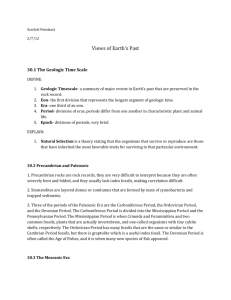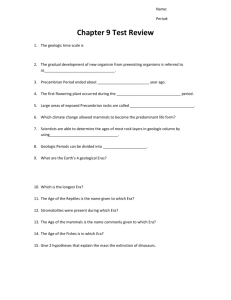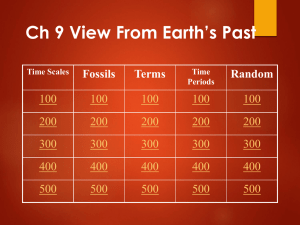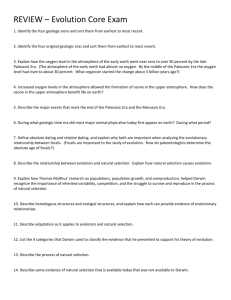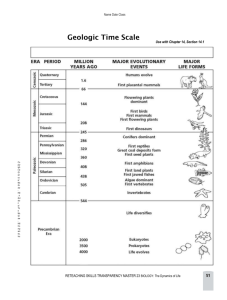Unit 3 Geological Time Reading Packet
advertisement
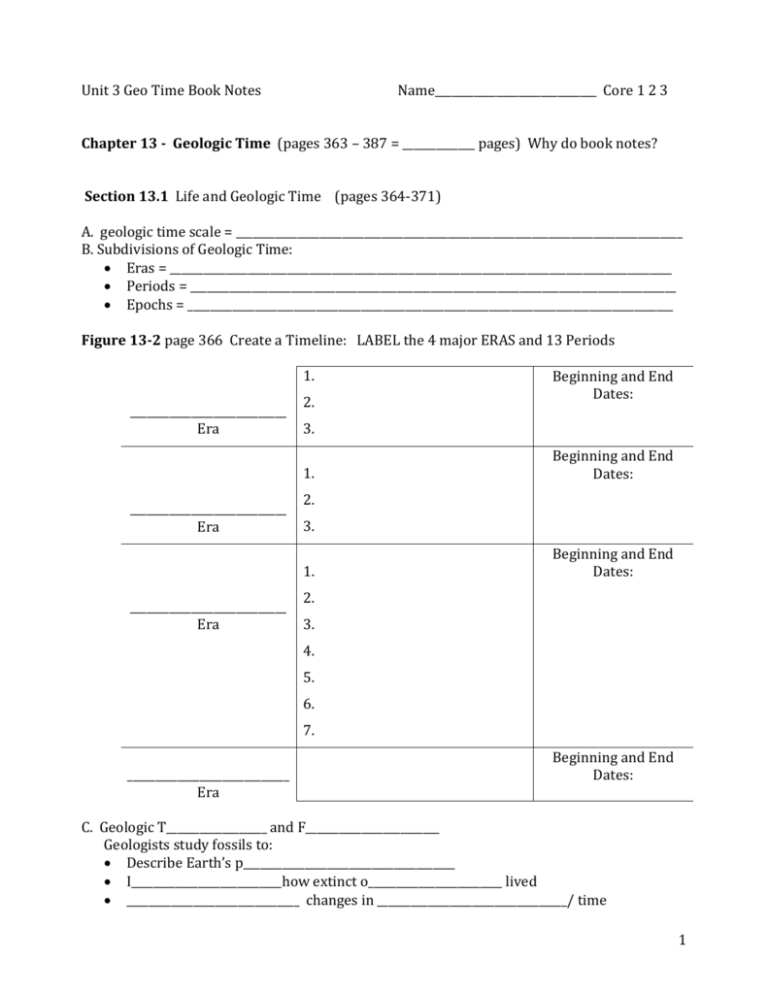
Unit 3 Geo Time Book Notes Name_____________________________ Core 1 2 3 Chapter 13 - Geologic Time (pages 363 – 387 = _____________ pages) Why do book notes? Section 13.1 Life and Geologic Time (pages 364-371) A. geologic time scale = ________________________________________________________________________________ B. Subdivisions of Geologic Time: Eras = __________________________________________________________________________________________ Periods = _______________________________________________________________________________________ Epochs = _______________________________________________________________________________________ Figure 13-2 page 366 Create a Timeline: LABEL the 4 major ERAS and 13 Periods 1. ____________________________ Era 2. 3. 1. ____________________________ Era Beginning and End Dates: 2. 3. 1. ____________________________ Era Beginning and End Dates: Beginning and End Dates: 2. 3. 4. 5. 6. 7. _____________________________ Era Beginning and End Dates: C. Geologic T__________________ and F________________________ Geologists study fossils to: Describe Earth’s p______________________________________ I___________________________how extinct o________________________ lived _______________________________ changes in __________________________________/ time 1 D. Using Math: Palezoic Era Longest Period: _______________________________ Shortest Period: _______________________________ E. Trilobites Time: ______________________________ Size: _____________________________________ Habitat: ____________________________________________________ Exoskeleton = ________________________________________________________ Why are they important? F. Figure 13-3 Trilobite Diagram eye, head cephalon body thorax tail pygidium F. Figure 13-4 Trilobite Glabella Change Over Time A. B. G. Figure 13-5 Trilobite Eye Change Over Time A B C C. D H. Figure 13-6 Physical Feature Changes: (Do a quick sketch of the progression of drawings.) Key Point # 1: In general, the trilobites changed in terms of ____________________________________________ and possibly as a result of ________________________________ I. Effect of Plate Tectonics – Causes _________________________________________________________________________________________ Example of how change can occur __________________________________________________________ Applied to trilobites -> _________________________________________________________________________ 13.1 Section Assessment: 1. What are the major subdivisions of geo time based on? __________________________________________ ____________________________________________________________________________________________________________ 3. How might plate tectonics affect all life on Earth. (Use Figure 13-8 to answer this question.) _______________________________________________________________________________________________ 2 Section 13.2 (pages 372- 378) E________________ E_______________________ History _________________ A. PPRECAMBIAN Time: L__________________________ __________ b_________________________ to _____________ m________________________ y_________ a__________ Fossils are sparse (rare) because ___________________________________________________________________ B. (Figure 13 – 9) cyanobacteria = _______________________ ______________________________________________________________ Stromatolite Drawing C. Why are cyanobacteria important? [Chemistry Integration pg 373] ____________________________________________________________________________ D. Invertebrates = ____________________________________________________ Developed near the end of the P_____________________________ Era Example: ________________________________________ Why few fossils of invertebrates? ____________________________________________________________ E. Ediacaran fauna = _______________________________________________________________________________________ Location: __________________________________________________ Drawings: Some Hypotheses: 1) soft bodied ancestors of Cambrian period life-froms; 2) ________________ _______________________________________; 3) _________________________________________________________________ F. PALEOZOIC Era Fossils are _______________________________________________________ Marked by organisms with ____________________________________________________ _________ million years ago (ya) Description of Earth’s surface: o ___________________________________ most life was m_____________________, lived in oceans Common Animals: ___________________________________________________________________________________ F________________ evolved during this era Broken into _____ periods. Key periods: o Cambrian -> ___________________________________________ o Ordovician -> A_________________________ Mountains; first v_____________________ = animals with _________________________________ o Silurian -> first p_______________________ on land o Devonian -> fish d________________________________ animal on Earth; First a________________ moved onto earth G. Life on Land Amphibians Reptiles How alike? How different? 3 H. Figure 13-13 page 377 – Key Points Coal Formed in s______________________________ areas P__________________________________-period forest ____________ million years ago (ya) I. End of an E_______________ m__________________ e_____________________________ @ end of P____________________ Era Cause: __________________________________________________________________________________ Pangaea = _______________________________________ occurred when: ________________________________ Climate changed from _________________________________ to _____________________________________________ 13.2 Section Assessment: page 378 1. What geologic events occurred at the end of the Paleozoic Era? _________________________________________ 3. Why is the Precambrian fossil record so sparse, rare? ____________________________________________________ 4. What major change occurred in the atmosphere during the Precambrian? _____________________________ 5. What major adaptations were needed for life to move onto the land? ___________________________________ Examples: ________________________________________________________________________________________________________ Science and Society page 380 F_________________ Track to E_____________________________________ 1. H________________________ Impact: Extinctions = __________________________________________________ __________________________________________________________________ __________________________________________________________________ o Evidence (Table) Trend _______________________________________________________________________ Endangered = ___________________________________________________________________________________________ Human Contributions: Directly Indirectly 2. Rain Forests: Key Point: _____________________________________________________________________________________ Supporting (2 – 5 bulleted): 3. Development w/ Habitat Protection - Key Point: _______________________________________________________ Supporting (2 – 5 bulleted): 4 Section 13.3 (pages 381-387) Middle and recent History A. MESOZOIC ERA – D______________________________!!! B. Panagea Breaks-up into separate c______________________________________________. ____________ million years ago (ya) Species that survived P______________________________ m_______________ e________________________ a_________________________________ d_____________________ c_______________________________ What helped reptiles adapt to new habitats? Hard s____________________________________ -> helped retain body fluid Hard e____________________________________ -> land births Reptiles d________________________ life-form in J________________________ period C. Figure 13-14 (page 381) Describe Mesozoic Era climate: __________________________________________________ D. Dinosaurs Size: _____________________ to ___________________________ ex: T. R____________ Diet: _____________________ to ___________________________ “good m________________________” ____________________________________________________________________ o Evidence: R________________________________ but some evidence not c____________- b_______________________ o Cold-blooded = _____________________________________________________________ o Maybe NOT c______________-blooded? Evidence: E. B___________________ Hypothesis _________________________________________________________________________ Evidence: (Figure 13-17 page 384) A) B) C) D) F. Reading Check: What characteristics link Archeopteryx to dinosaurs? ______________________ G. gastroliths = _________________________________________________________________________________ H. Gymnosperms Angiosperms How alike? 5 Examples: I. Figure 13-18 (page 385) Angiosperms & insects Key Point: _______________________________________ J. KEY Point: T______________________ plates continue to move ________________________________________ which causes ________________________________________________________________________________________________ K. CENOZOIC ERA Era of r______________________ life Time: __________________________ Climate: ________________________________________________________________ Divided into 3 periods: ___________________________ ___________________________ ______________________ We live in Q______________________________ period H__________________________ epoch – which began after the last i____________ a__________________ L. Time of M______________________ Building Alps formed by _______________________________________________________________________ Himalayas formed by ________________________________________________________________ Key Point: tectonic plates colliding m_______________________________ M. Food Web: flowering plants i_________________ & p____________ eating animals (h____________________) c_____________ N. Further Evolution of Mammals 1. Small around same time as d______________________________ 2. Some returned to sea example: ancestors of w________________________ & d__________________________ 3. Isolated forms (e.g. A_____________________________) m______________________________ - kangaroos M. Homo sapiens Time: _______________________________________ Became dominant ____________________________________ ya Hypothesis: ____________________________________________________________________________________________ o Evidence: 13.3 Section Assessment 1. In which era, period and epoch did Homo sapiens first appear? Era: ____________________________ Period: ________________________ Epoch: _______________________________ 2. How did the development of hard seeds enable angiosperms to survive in a wide variety of climates? 3. What evidence indicates that dinosaurs were warm-blooded? 6 4. What is the connection between plate tectonics and the occurrence of marsupials? 7



